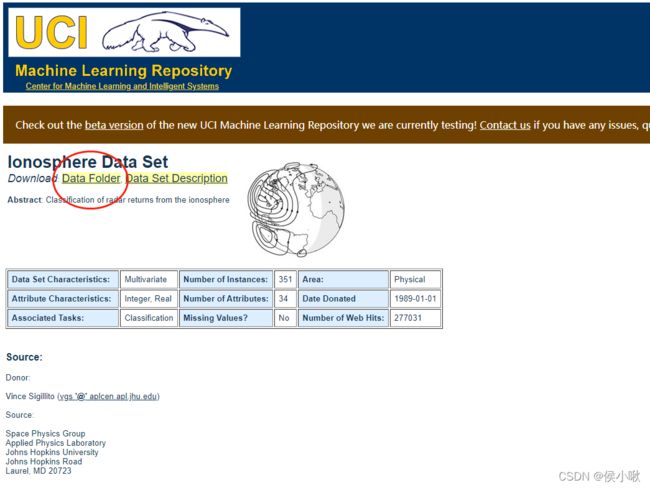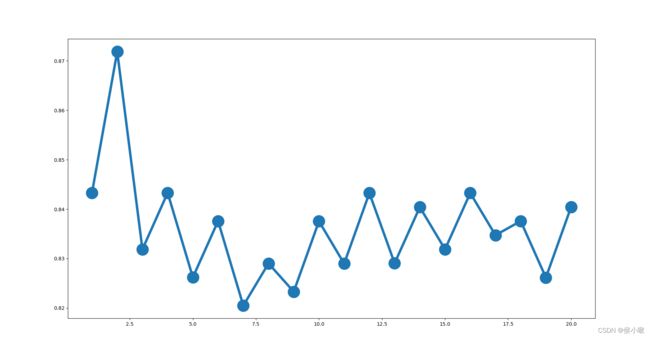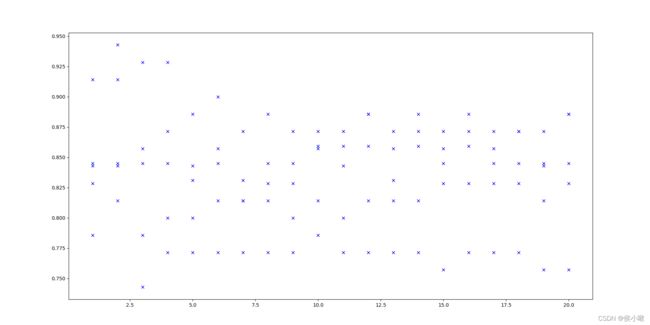python机器学习_近邻算法_分类Ionosphere电离层数据
文章目录
- 摘要
- 1.数据获取
- 2.数据集分割与初步训练表现
- 3.测试不同近邻值
- 4.交叉检验
- 5. 十折交叉检验
- 6.输出预测结果
摘要
本文使用python机器学习库Scikit-learn中的工具,以某网站电离层数据为案例,使用近邻算法进行分类预测。并在训练后使用K折交叉检验进行检验,最后输出预测结果及准确率。过程产生一系列直观的可视化图像。希望文章能够对大家有所帮助。祝大家学习顺利!
1.数据获取
1.点击链接获取数据
数据获取链接
http://archive.ics.uci.edu/ml/datasets/Ionosphere
2.点击Data Floder

3.选择ionosphere.data和ionosphere.name这两个文件并下载

4.下载后放在指定目录下,可以直接通过pycharm查看数据的基本信息
ionosphere.data是我们需要用到的数据,

ionosphere.name是对该数据的介绍。
从ionosphere.name中可以看到,ionosphere.data共有351个样本,34个特征,且第35个表示类别,有g和b两个取值,分别表示“good”和“bad”。

2.数据集分割与初步训练表现
import os
import csv
import numpy as np
from sklearn.model_selection import train_test_split
from sklearn.neighbors import KNeighborsClassifier
from sklearn.model_selection import cross_val_score
from matplotlib import pyplot as plt
from collections import defaultdict
data_filename = "ionosphere.data"
X = np.zeros((351, 34), dtype='float')
y = np.zeros((351,), dtype='bool')
with open(data_filename, 'r') as input_file:
reader = csv.reader(input_file)
# print(reader) # csv.reader类型
for i, row in enumerate(reader):
data = [float(datum) for datum in row[:-1]]
# Set the appropriate row in our dataset
X[i] = data
# 将“g”记为1,将“b”记为0。
y[i] = row[-1] == 'g'
# 划分训练集、测试集
X_train, X_test, y_train, y_test = train_test_split(X, y, random_state=14)
# 即创建估计器(K近邻分类器实例) 默认选择5个近邻作为分类依据
estimator = KNeighborsClassifier()
# 进行训练,
estimator.fit(X_train, y_train)
# 评估在测试集上的表现
y_predicted = estimator.predict(X_test)
# 计算准确率
accuracy = np.mean(y_test == y_predicted) * 100
print("The accuracy is {0:.1f}%".format(accuracy))
# 进行交叉检验,计算平均准确率
scores = cross_val_score(estimator, X, y, scoring='accuracy')
average_accuracy = np.mean(scores) * 100
print("The average accuracy is {0:.1f}%".format(average_accuracy))
如图,该分类算法准确率可达86.4%,交叉检验后的平均准确率可达82.6%。属于是比较优秀的算法。

3.测试不同近邻值
测试不同的 近邻数 n_neighbors的值(上边默认为5)下的分类准确率,
选择近邻值从1到20的二十个数字,
并绘图展示
avg_scores = []
all_scores = []
parameter_values = list(range(1, 21)) # Including 20
for n_neighbors in parameter_values:
estimator = KNeighborsClassifier(n_neighbors=n_neighbors)
scores = cross_val_score(estimator, X, y, scoring='accuracy')
avg_scores.append(np.mean(scores))
all_scores.append(scores)
# 绘制n_neighbors的不同取值与分类正确率之间的关系
plt.figure(figsize=(32, 20))
plt.plot(parameter_values, avg_scores, '-o', linewidth=5, markersize=24)
plt.show()

可以看出,准确率整体趋势随着近邻数的增加而减小。近邻值为2时准确率最高。
4.交叉检验
把交叉检验每次验证的准确率也绘制出来
(20个近邻值每个对应5个训练集,对应5次检验)
for parameter, scores in zip(parameter_values, all_scores):
n_scores = len(scores)
plt.plot([parameter] * n_scores, scores, '-o')
plt.show()
plt.plot(parameter_values, all_scores, 'bx')
plt.show()
5. 十折交叉检验
all_scores = defaultdict(list)
parameter_values = list(range(1, 21)) # Including 20
for n_neighbors in parameter_values:
estimator = KNeighborsClassifier(n_neighbors=n_neighbors)
scores = cross_val_score(estimator, X, y, scoring='accuracy', cv=10)
all_scores[n_neighbors].append(scores)
for parameter in parameter_values:
scores = all_scores[parameter]
n_scores = len(scores)
plt.plot([parameter] * n_scores, scores, '-o')
plt.plot(parameter_values, avg_scores, '-o')
plt.show()
检验结果如下图所示:

因为每个近邻值下,10次检验中的准确率可能会有重复值,所以在图像中每个近邻值上的准确率个数会有差异。
6.输出预测结果
这里用测试集作为待测数据,使用上述算法进行预测,并输出预测结果,
且令n_neighbors=2
Estimator = KNeighborsClassifier(n_neighbors=2)
Estimator.fit(X_train, y_train)
Y_predicted = Estimator.predict(X_test)
accuracy = np.mean(y_test == Y_predicted) * 100
pre_result = np.zeros_like(Y_predicted, dtype=str)
pre_result[Y_predicted == 1] = 'g'
pre_result[Y_predicted == 0] = 'b'
print(pre_result)
print("The accuracy is {0:.1f}%".format(accuracy))



